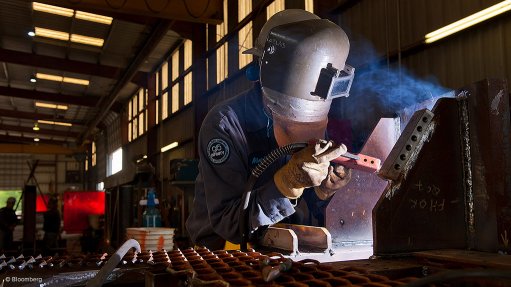
Photo by: Bloomberg
The 2% year-on-year contraction in April’s manufacturing output has put to bed any expectation of the metals and engineering sector improving in 2015, the Steel and Engineering Industries Federation of Southern Africa (Seifsa) said this week.
“The flicker of light reflected by the improved January production data has now well been snuffed out,” claimed Seifsa chief economist Henk Langenhoven, pointing to a decline in “virtually every component” in the metals and engineering sector during April.
Statistics South Africa reported that the 2% decline in manufacturing production was a result of a 4.5% decrease in basic iron and steel, nonferrous metal products, metal products and machinery; a 2.8% drop in petroleum, chemical products, rubber and plastic products; a 15.3% fall in radio, television and communication apparatus and professional equipment and a 2.3% contraction in wood and wood products, paper, publishing and printing.
Seasonally adjusted manufacturing production increased by 0.1% in the quarter to April 30, compared with the previous three months. Four of the ten manufacturing divisions had reported positive growth rates over the three-month period, with the largest positive contribution from the motor vehicles, parts and accessories and other transport equipment division, with a 6.3% rise.
The largest negative contribution was made by the petroleum, chemical products, rubber and plastic products division, which contracted by 3.1%.
Langenhoven said, on an annualised basis, production in April had declined by 3.8% compared with April 2014.
“Production in April was only 0.9% lower than in March, but the first four months of the year recorded a 3.3% decline compared to the same period in 2014.”
“It is now clear that the small recovery recorded over the first two months was simply a normalisation after the instability of late 2014,” he said, adding that the fears that the negative sentiments reflected by the business activity subindex of the Purchasing Managers Index (PMI) and the quarterly manufacturing surveys of the Bureau of Economic Research (BER) would be followed by actual production declines had now come to pass.
The declines in April, compared with March, collectively accounted for 25% of the sector.
“Theoretically, the link between current and future production is the level of inventories – as inventories increased owing to low or declining orders from customers, production had to be curtailed.
“Inventories are increasing in the sector, according to data from the Kagiso/BER PMI, as well as the BER Quarterly Manufacturing Surveys. With virtually all business condition indicators for the sector pointing downwards, it indicates that production will slow down further in the coming months,” he concluded.